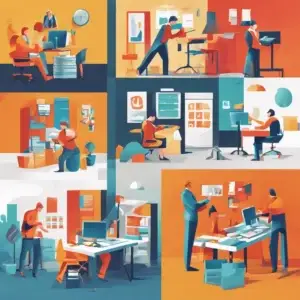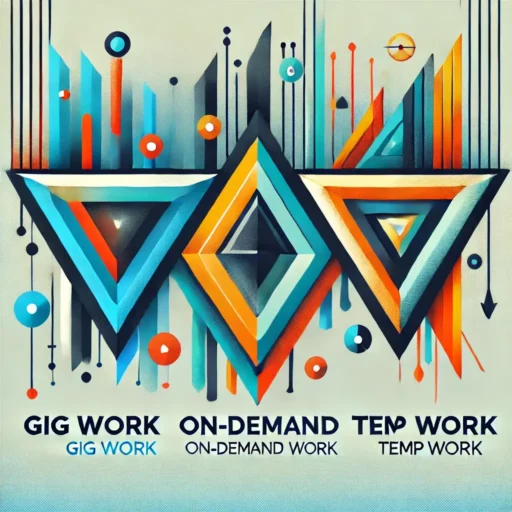Table of Contents
Comprehensive Overview of the Gig Economy: A Deep Dive into Modern Work Trends
The gig economy has emerged as a transformative force in the modern labor market, revolutionizing how we think about work, employment, and career development. From its humble beginnings in the early 20th century to today’s digital platforms, the gig economy has evolved into a complex ecosystem that offers both opportunities and challenges for workers and businesses alike. Through this comprehensive exploration, we’ll delve into the multifaceted world of gig work, examining its historical roots, current state, and future trajectory as we approach 2025.

In this FlashJobs Pillar Content Series, we’ll navigate through the essential aspects of the gig economy, from understanding its fundamental principles to analyzing the intricate balance between regulation and market freedom. We’ll explore the key differences between gig work and traditional employment models, examine the growing importance of worker protections, and highlight the diverse opportunities available across various sectors. Whether you’re a seasoned gig worker, considering entering the gig economy, or simply interested in understanding this revolutionary shift in the labor market, this series provides valuable insights into the dynamic world of gig work and its impact on the future of employment.
2025: The Fascinating History And Evolution Of Gig Economy
The gig economy’s journey spans over a century, from early temporary work in the 1900s to today’s digital platforms. Key milestones include the rise of temp agencies in the 1950s-60s and the internet revolution enabling remote work. The 2008 financial crisis sparked platforms like Uber and Airbnb, while the term “gig economy” gained traction by 2015. The COVID-19 pandemic in 2020 accelerated its growth through widespread remote work adoption. As 2025 approaches, AI and automation continue to transform gig work, challenging traditional employment models and sparking ongoing debates.
Pros And Cons Of Gig Work Vs Traditional Employment In Gig Economy

Gig work offers appealing benefits like flexibility, work-life balance, and multiple income opportunities, allowing workers to pursue entrepreneurial ventures. However, it comes with challenges, including income instability, lack of benefits, and potential isolation. In contrast, traditional employment provides job security, regular paychecks, benefits, clear career paths, and workplace relationships. The choice between gig work and traditional employment depends on personal preferences and circumstances, with gig work particularly attractive to Gen Z and those seeking adaptable opportunities, despite the self-management burden and psychological challenges.
Navigating The Gig Economy: Regulation Vs Free Market On Gig Work

The gig economy presents a complex challenge in balancing regulation and free market principles. While regulators push for worker protections, including minimum wage, benefits, and job security, free market advocates warn against stifling innovation and flexibility. Key debates centre on worker classification, benefits, fair compensation, and platform accountability. Policymakers must address ethical concerns like data privacy and algorithmic management while maintaining sector growth. Success requires adaptive policies and ongoing dialogue between stakeholders to create a sustainable and equitable gig work environment.
Regulation Enhancing Gig Work And Worker Protections In The Gig Economy

Governments worldwide are adapting regulations to address the unique challenges of gig work while maintaining its flexibility. Key focus areas include fair pay, benefits access, and anti-discrimination protections. Some jurisdictions are creating new worker categories between employees and independent contractors. Updated labor laws extend protections like minimum wage, healthcare, and pension benefits to gig workers. Regulations also emphasize transparency in pay rates and job expectations. As the sector grows, regulatory frameworks continue evolving to ensure worker protection while supporting the gig economy’s dynamic nature.
The History Of The Gig Economy: Its Impact On Various Sectors

The gig economy evolved from early 20th-century freelance work to its modern form in the late 2000s, catalyzed by the 2008 financial crisis and technological advances. Key platforms like Uber (2009), TaskRabbit (2010), and Airbnb (2013) revolutionized their respective sectors. The impact spans multiple industries: ride-sharing transformed transportation, short-term rentals disrupted hospitality, and professional services embraced on-demand specialized skills. The rise of e-commerce and food delivery apps created new opportunities for independent contractors, continually shaping work dynamics in the digital era.
Gig Work Vs. Part Time Jobs: Key Differences

Gig work and part-time jobs represent distinct employment models. While gig workers are independent contractors with flexible schedules and diverse project opportunities, part-time employees work regular hours for a single employer. Part-time jobs offer more stability through predictable income, potential benefits, and clearer career advancement paths. However, gig work provides greater scheduling freedom and varied skill development opportunities. Key differences also include tax responsibilities, with gig workers managing their own taxes, and job security, which tends to be stronger in part-time positions.
What The Gig Economy Offers: Top Jobs For Gig Workers In 2024

The 2024 gig economy presents diverse opportunities across multiple sectors. Digital platforms like Upwork connect freelancers with clients in writing, design, and web development. Traditional gig work remains strong in ride-sharing and food delivery through companies like Uber and DoorDash. Professional services, including consulting and legal work, are increasingly adopting gig arrangements. Growth areas include e-commerce support, digital marketing, tech services, and creative fields. The hospitality sector offers opportunities through platforms like Airbnb, while tech professionals find project-based work in software development and data analysis.
What Is Gig Work In The Gig Economy?.

Gig work encompasses temporary, flexible jobs where individuals work as independent contractors or freelancers through digital platforms. Common areas include ride-sharing, food delivery, freelance writing, virtual assistance, tutoring, and home services. Gig workers enjoy schedule and location flexibility, often managing multiple gigs simultaneously. However, they must handle their own taxes, insurance, and benefits without traditional employee perks. This growing employment model spans various industries and skill levels, driven by technology and changing work preferences, serving as either supplemental income or full-time career opportunities.
The Differences Between Temp On-Demand And Gig Work

While both offer flexible employment, temp on-demand and gig work have distinct characteristics. Temp workers are typically employees hired through staffing agencies for specific shifts or projects, potentially receiving benefits and steadier income. In contrast, gig workers are independent contractors with greater schedule control and job choice flexibility, though without benefits. Temp jobs often require specific skills and last longer, while gig work varies in skill requirements and duration. The choice between them depends on individual preferences for stability versus flexibility in the modern workforce.
Conclusion: Embracing the Future of Work in the Evolving Gig Economy
The gig economy represents a fundamental shift in how we approach work, offering a complex tapestry of opportunities and challenges that continue to reshape the employment landscape. As we’ve explored throughout this comprehensive series, from its historical evolution to current regulatory frameworks and the distinct characteristics that set it apart from traditional employment models, the gig economy has become an integral part of our modern workforce.
While it presents certain challenges, including income instability and benefit considerations, its flexibility and diverse opportunities make it an attractive option for many workers, particularly in our increasingly digital world. As we look toward the future, the success of the gig economy will largely depend on finding the right balance between worker protection and market flexibility, ensuring that this dynamic employment model remains sustainable, equitable, and beneficial for all stakeholders involved.






